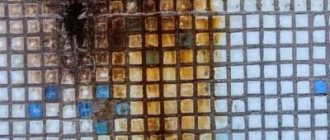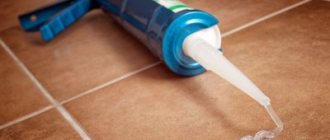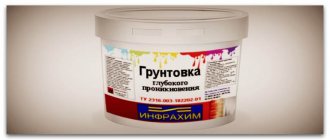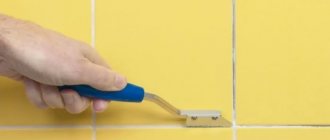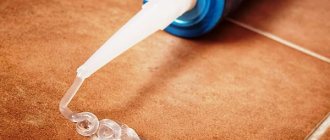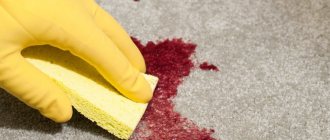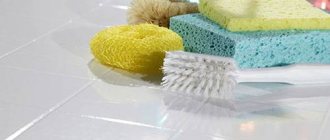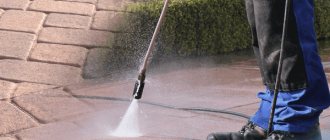Almost everyone knows this situation when you have just completed a fresh renovation and then you notice a trace of grout or primer on a perfectly clean tile in the bathroom, left behind by the builders or accidentally done by yourself due to not very careful work. This problem is especially acute for owners of embossed ceramic tiles with a ribbed and matte rough surface, because it is much more difficult to remove dirt from them. This, of course, noticeably spoils the mood of the homeowner, darkening the joy of the renovation just completed, and questions immediately arise - what to do in such a situation and how to wipe off the grout from the tiles that dried out a few days ago..
There is no need to run anywhere or surf the forums once again, looking for bits of useful information - for you we have collected the best tips and methods for dealing with the problem of tile contamination with building substances at home. And for greater clarity, we accompanied this article with illustrative material, namely photos and videos.
Epoxy grout left on tiles
Grouting mixtures are made based on epoxy resins. In most cases, cement-based mixtures are used. They are cheaper, which pays for the higher costs. Cement grouts delight with their color variety, high strength and durability.
Epoxy fugues are different:
- optimal viscosity and fluidity, which allows you to fill the joints between tiles well;
- moisture resistance;
- durability and beautiful appearance.
So, such fugues are used for covering grout joints on tiles in rooms with high humidity, for outdoor work, and for finishing cladding of swimming pools. But what to do if the grout remains on the tiles?
Epoxy grout can be removed in different ways:
- heating the resin stain;
- freezing the soiled base;
- household chemicals.
Protecting seams from contamination
Having determined the degree of contamination, choosing a cleaning agent suitable for the task, and having successfully applied it, you should perform some more actions aimed at maintaining the achieved result. To preserve the appearance of the tile grout and extend its service life, use protective solutions, for example, Atlas Dolphin or similar. Application of such coatings in the future greatly facilitates surface care and protects the grout. Working with protective liquids requires care and precision. Do not allow the solution to get on the tiles. To apply protection, use a thin brush. Applying a protective coating does not eliminate the need for regular maintenance, and the use of professional care products will prolong the “youth” of the grout for many years.
The use of all of the above methods and means for cleaning seams does not require special training or high qualifications. All that is required is patience, calm and accuracy. Do-it-yourself work will not only save a significant part of your household budget, but will also give you confidence in your abilities.
Features of removing epoxy grout
When figuring out how to clean epoxy grout, remember that such a composition, after hardening, turns into a super-strong substance. Epoxy has a long service life - more than 35 years, without changing its characteristics or appearance.
Epoxy resin-based grout is resistant to known and common cleaners. Such as abrasives, detergents, and acidic solvents.
Therefore, to remove traces of grout, specially created products are used. Of course, the best option is to clean the marks immediately after applying the working material, before polymerization. A freshly applied substance is much easier to remove than an already hardened one. But a special remover for epoxy grout helps remove traces of the mixture that has already hardened. Moreover, without the involvement of masters, on our own.
Relief tiles
The greatest problems most often arise with tiles that have a corrugated surface. It consists of numerous small grooves, various grooves and depressions, where grout is retained when sealing joints. It hardens over time, and it is difficult to remove it using a rag soaked in water or even a special composition.
Therefore, the first thing you need to do, in order not to create problems for yourself, is not to rush with the work, but to seal the seams in a small area, even if it takes not 1, but 2-3 days.
Having filled a small space with the fugue, you need to wait until it sets, and then rinse thoroughly several times with a cloth soaked in water. After this, you need to take a sponge with a rough surface (a double-sided one, used for washing dishes, is suitable) or a small hard brush and use it to wash the remaining grout from the relief depressions of the tile.
Relief tiles are difficult to clean from grout.
In this case, you need to take as little water as possible so that its excess does not soak the beveled seam. After each approach, you need to wipe the tiles with a dry cloth, and clean the remaining contaminated areas again in the same way. After the jointed fragment has been completely washed, you can begin processing the seams of the next part of the wall or floor. Yes, the process is long, but if the fugue hardens “tightly”, then it will take even longer to pick it out from the relief tile.
A good way to prevent the grout from spreading over the entire surface of the tile is to use a special bag to fill the joints between the tiles. It is somewhat similar to a candy store. The metal tip on the edge of the container allows you to more accurately and evenly fill the empty space between the tiles with a fugue. In this case, horizontal seams are processed first, and then vertical ones.
When the moment has been missed, the best thing that can be done is to resort to the help of a special grout removal compound called a remover (for example, Atlas Szop). But since this is an aggressive chemical containing acid, you need to be careful with it - first try it on an inconspicuous area of the tile, somewhere in the corner, to check whether it will damage the surface of the finishing material.
Mechanical methods involving the use of metal brushes or sharp objects are unacceptable, since their use can lead to the loss of the attractive appearance of the tiles, the appearance of scratches and chips.
Porous materials
The most problems always arise with porous tiles, because they absorb all the dirt, not to mention the fugue. Therefore, the main way is prevention. In order to ensure that as little grouting material as possible gets into the pores, before starting jointing, you can treat the surface with a protective compound - Sopro AH737, for example.
Porous tiles absorb all dirt.
The product is carefully applied in a circular motion to the surface of the tile, and then, after the fugue has dried, it is removed along with it. The film formed on the tile will protect the pores from penetration of the grouting material into them, and at the same time will save you from labor-intensive work on its removal.
If problems cannot be avoided, you will have to use chemicals - acid removers or solvents. Their action is based on penetrating into the pores of the tile and pushing out contaminants, including fugue.
Fresh, just dried grout is best removed using a special felt glove dipped in vegetable oil.
Glossy surfaces
Grout is the easiest to remove from glossy surfaces. The main thing is not to use abrasive materials, since the tiles can be scratched by powder with strong friction or with a metal brush. Therefore, methods should be as gentle as possible, using soft sponges, water and non-aggressive detergents.
Removing fresh grout
The setting time for grout mixtures varies from 10 to 20 minutes, and during this time it is necessary to clean off excess mortar from the ceramic coating. While the fugue has not hardened, this is easy to do using a sponge with water. To clean the tiles from the grout after repair, when it has already hardened, more effort will be required.
The work must be done quickly and carefully so as not to damage the seam or wash off more material from it. If there is a lot of excess, then it may not be possible to wash cleanly the first time. It will take several passes, and you should thoroughly rinse and wring out the sponge.
If the composition has already set, and it is necessary to replace the material in the seams, then to remove it it must be moistened generously with water. It will soften and become pliable to remove with hand tools.
Recommended cleaning times
Removal of the grout layer is carried out in several stages - from the initial removal of excess to dry and wet cleaning. It is better to carry out the first stage when the material has not yet hardened, but has already hardened sufficiently. In this case, the risks of damaging the surface of the tile and disrupting the hardening process of the putty are minimized.
It’s easy to check the condition of the seams - just moisten them with a damp cloth and evaluate the reaction.
If, after interacting with the liquid, the grout mass begins to increase in size and extend beyond the seam, it is too early to begin cosmetic work. If the layer remains unchanged and does not react to water in any way, then the moment for cleaning is most suitable.
Reference! The average initial setting time for tile grout is about 30 minutes.
Removing cement grout
Removing fresh but set grout from tiles is easy. To do this, you can use home remedies, for example, baking soda and vinegar.
But if the fugue is overexposed and a day has passed since application, then in this case only acid-based chemicals will help. They are available in the form of liquid solutions suitable for any type of cladding, or powders that cannot be used to clean marble and porous surfaces.
When working with such products to remove grout from tiles, you need to wear rubber gloves and a respirator. First, it is recommended to test the product on an inconspicuous area of the cladding to make sure that the solution does not harm it.
Residues of the cleanser are removed with a damp sponge in 2 stages. First, the surface is wiped with a water-salt mixture (2 teaspoons of salt per 1 liter of water). Baking soda, which is an alkali, neutralizes an acidic solution. After this, the cladding is cleaned using clean water. At the end, it is recommended to wipe the tiles dry to prevent streaks from appearing on its surface.
Briefly about the main thing
Over time, the seams of the tile cladding lose their attractive appearance, and then the old grout is disposed of to replace it with a new one. There are two main ways to clean tiles: chemical and mechanical.
Chemicals are selected taking into account the sealant material, which may have a cement, epoxy or silicone base. The chemical softens the grout, after which it is removed with a knife. The mechanical method involves using a knife (or any other suitable blade) or a power tool. Mechanical removal is best combined with chemical treatment.
Removing Epoxy Grout
Removing epoxy grout is more difficult because they are resistant to alkalis and acids, so to remove them you will need strong products designed specifically for this purpose.
Among the products presented in the range of products for removing epoxy grout, one can use it to clean porcelain tiles, natural stone and mosaics. "Litonet gel" has a thicker consistency and is suitable for working with walls.
Before starting work, the seams must be sealed with masking tape to prevent solvent from getting into the seam. After this, the softening liquid is applied to the contaminated areas and after 10 minutes. washed off. You can clean the grout from embossed tiles using a wire brush. When working, you need to control the force of pressing the tool so as not to damage the surface of the tile.
After cleaning the excess epoxy fugue, the facing surface should be washed with a sponge soaked in a soapy solution.
FAQ
Is it possible to tape the tiles so that the grout can be applied evenly?
The tape may leave adhesive areas on the surface that will have to be cleaned additionally. It is better to use masking tape, which is easier to remove from the surface.
Do I need to use a respirator when removing grout residue with an acid-free product?
It is best to read the instructions on the packaging and act according to them.
What is the best way to seal porcelain tiles if the floor area is huge?
In this case, it is better to take a special solution that is applied before grouting. It forms a thin film on the surface of porcelain stoneware, on which the grout does not polymerize. After work, rinse it off carefully with warm water and a soft sponge.
Is there a way to clean grout from porcelain tiles if it is more than a month old?
This will be extremely difficult to do, but you should start with acidic cleaners.
Can the cleaner be applied before the grout is used?
This makes no sense, so it is better to take all measures to prevent the formation of pollution.
How to remove traces of glue on tiles
Often, traces of not only dried fugue, but also tile adhesive remain on the cladding. To avoid problems with cleaning after the renovation is completed, it is recommended to wash the tiles with a sponge soaked in water during the installation process. Fresh glue is removed easily and quickly, and the procedure itself does not take much time. But no matter how the master is washed, small dried pieces of the composition may remain in some places.
It is recommended to wash the tiles with a sponge moistened with water.
To remove these traces, you can:
- Use mixtures based on vinegar, citric acid, ammonia (as in the case of cement grout).
- Remove any remaining tile adhesive using a spatula, scraper or sandpaper, being careful.
- Use chemicals designed to remove cement or hydrochloric acid.
Radical methods
In particularly difficult cases, when the damage to tile joints by mold or fungus has gone so far that neither professional nor folk remedies help, there are only two options left:
- Completely remove the old tiles, treat the surfaces with antifungal agents and lay new tiles in compliance with all technologies;
- Remove all grout from infected joints, treat with an anti-fungal agent, rub the joints with fresh grout, and cover with a protective layer to prevent re-infection.
In both the first and second cases, it makes sense to use the services of professional tilers. The pleasure is not cheap, but the result is guaranteed. The main thing is to control the removal of the adhesive so that you don’t have to worry about how to remove old tile adhesive from the tiles.
If this is not possible, and only the second option is available for independent execution, we recommend that you consider the following tips:
- Use a scraper, painting knife, chisel or power tool - drill, screwdriver, electric chisel, grinder.
- Safety rules come first! When working with power tools, you should only wear safety glasses and a mask.
- A weak vinegar solution is suitable for softening the grout.
Safe products and tools
To remove the grout, use a special scraper.
You can clean the grouting material from the floor and walls with a scraper, brush or pumice stone. This is a monotonous and difficult way to get rid of dried fugue. It takes a lot of time and effort, but the risk of damage to the tile coating is minimized.
Before you wash the grout off the tiles, try to initially remove dirt in a small area with a scraper or brush. Decide which tool is more convenient to work with. For best results, wet the stains and, with some effort, remove them.
Safe chemistry
You can clean the tiles from the fugue after repair by using special chemical liquids for cleaning ceramics from mortars. As a rule, these are acid preparations to destroy the remains of epoxy or cement fugue. Before starting work, you need to test the detergent on a small, inconspicuous area. It is also recommended to protect all surfaces made of synthetic materials, such as PVC, acrylic, etc.
Choose products from well-known manufacturers, read the composition and pay attention to what type of fugue the product is intended for.
Liquids for cleaning cement and epoxy deposits:
- Prosept Cement Cleaner. Concentrated liquid effectively removes old stains and stains. Before washing the grout from smooth and textured tiles, the detergent must be diluted with water 1:5. Spray the liquid onto the work surface with a spray bottle. After ten minutes, remove the residue with a damp sponge or lint cloth. Afterwards, thoroughly wash the surface with clean water 1-2 times.
- Fila CR10. Professional cleaner for removing epoxy fugue residues. Removes stubborn and old stains. Shake the container with liquid before use. Apply undiluted product with a brush to the entire surface of the dirt. Leave for 15-25 minutes. The most stubborn stains can be scrubbed with a stiff brush or spatula and rinsed thoroughly with water. Repeat if necessary.
- Atlas Szop. Cement residue cleaner. The liquid effectively removes both fresh and old cement stains on the ceramic surface. The cleaner is not recommended for use on substrates that are unstable to its influence, for example, marble. Depending on the contamination, it should be diluted with water. To remove stains and deposits of cement fugue, the ratio of water and product will be 1:3; for old large stains there is no need to dilute it. Apply the solution to the stains with a sponge. Leave for 10 minutes and then remove any remaining residue. Rinse the surface thoroughly with clean water.
- Litokol Litonet Pro. Liquid cleaner for epoxy fugue residues. The jelly-like product removes marks and stains from ceramics of various textures and shapes. It even copes with dried dirt on the walls without running down. The cleaner does not need to be diluted. The product must be distributed evenly over the entire surface. Wait 25 minutes and remove with any remaining grout. Once cleaning is complete, rinse the tiles with clean water again.
- Clean Kiilto. Acidic liquid for removing building cement mortars. Before applying the cleaning product, you need to moisten the stains with water. Then use a sponge with solvent to treat all stains. Wait 20 minutes and clean the surface. Using a hard plastic brush can speed up the removal of dirt.
- Keranet Mapei. Acidic product for removing cement grout from tiles. Available in the form of a solution and concentrated powder. The main component is organic acid. Removes traces of cement mortar and does not damage the joints between tiles.
- Unicum. The concentrated product is intended for removing fugue and putty. It must be applied evenly and spread with a sponge onto the stain. After 20 minutes, wipe with a cloth and wash the surface of the cladding with water.
- Starwax. Cement based grout remover. Effectively removes old and stubborn dirt. The solution does not need to be diluted with water. It is necessary to apply the product to stains or stains, wait 15 minutes and use a plastic brush to remove the remaining fugue. Afterwards, rinse everything off with clean water and wipe the surface dry with a cloth.
Remove sealant from surface
- Dry method, when filling joints with sealant at an angle of 90 degrees, you need to hold a trowel (after hardening, this method is useless).
- Wet cleaning. This is carried out after the sealant has completely hardened - checked with a damp cloth, if after running along the seams, there are no traces on it, you can start working. Wipe the tiles with a slightly damp sponge (excessive moisture will destroy the grout).
Less effective method
Special means
You can deal with the remains of the building mixture on the tiles using special household products that contain acid. These are highly active solutions and various powders based on the specified component. It is worth noting that products containing organic acids are ideal for removing other contaminants after repairs.
Compositions with acid quickly remove stains from glue and primer solutions. This category also includes traces of grout (even colored ones), which quickly harden on the tiles. Also, special products give the treated spaces between the tiles a uniform appearance.
When choosing such washes for cleaning fugue, it is necessary to take into account the technical properties of the material. It is worth checking in advance whether the tiles are resistant to chemical influences. Otherwise, marks from contact with the acid may remain on the surface, which will be impossible to remove in the future.
Particular attention should be paid to liquid formulations and gel cleaners. According to many experts, they are the ideal choice for cleaning all types of surfaces. The principle of operation of these compositions is to create a quick reaction that softens the building mixture.
As for powder options, they should be used with caution.
They can be especially dangerous for:
- marble tiles;
- granite finishes;
- materials from marble chips.
It is also not advisable to use powders for removing grout from limestone surfaces.
When choosing household compounds for removing stains from tiles, you need to take into account the fact that they all differ from each other in different percentages of acid. Many varieties also contain flavorings and other components. Carefully study the composition before purchasing, because the wrong product can ruin the finish.
If you decide to clean your tiles using professional methods, be sure to follow the manufacturer's instructions. As for auxiliaries, it is also better to use sponges with a soft base to remove old and dried fugue. Please note that you should never use metal objects or hard-bristled brushes to clean ceramic tiles, as they can scratch the material.
Be sure to wear gloves before using products containing acid. Cleaning must be done carefully. Make sure that the solution does not come into contact with the skin and mucous membranes.
Prohibitions when deleting
When removing grout, it is important to remember a number of prohibitions:
- You cannot use purchased solvents that are not intended for removing grout from tiles, as ignoring this point can lead to damage to the surface.
- You cannot begin general cleaning of the surface until the grout has completely dried and the main contaminants have been removed. Violating this rule may result in damage to the compound between the tiles.
- You should not use solvents, even homemade ones, with your bare hands. Rubber gloves are a necessary means of protection.
- Do not use a metal scraper or knife to clean directly on the tiles. Such a tool can leave damage not only on a glossy surface, but also on a matte and embossed one.
Recommendations for preventive maintenance of tiles
To keep your ceramic tiles looking their best, consider the following tips:
- Use only soft sponges to wash tiles. Abrasive sponges can damage the glossy surface, resulting in dull spots;
- liquid formulations without abrasives should be used as a cleaning agent;
- When cleaning porcelain stoneware, it is permissible to use a weak solution of hydrochloric acid. It not only helps get rid of dirt in the porous surface on the floor, but also kills pathogenic bacteria that actively multiply in a humid environment.

